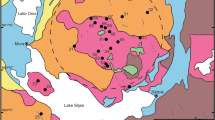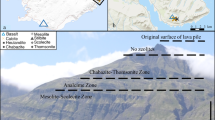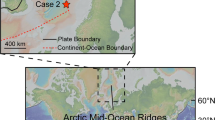Abstract
The fission track method has become acceptable in geochronology, not only in straightforward dating of igneous and metamorphic events but also in stratigraphic studies by the dating of ash layers1,2, the elucidation of crustal uplift history3–7, and in archaeology8. Such studies have mostly used accessory minerals such as apatite, sphene and zircon, whose track-retentive properties are well documented. However, fission tracks can be developed and observed under the optical microscope in most minerals9–11. We report here on reconnaissance studies of fission track dating of zeolites, a complex group of tectosilicates, which is, for example, widely developed in basaltic rocks after their emplacement by later stage processes. We describe the etching conditions for some zeolites, in particular the minerals chabazite, stilbite and heulandite12 and detail the track recording and retention characteristics for chabazite, with particular reference to fossil hydrothermal systems in the Faeroe Islands.
This is a preview of subscription content, access via your institution
Access options
Subscribe to this journal
Receive 51 print issues and online access
$199.00 per year
only $3.90 per issue
Buy this article
- Purchase on Springer Link
- Instant access to full article PDF
Prices may be subject to local taxes which are calculated during checkout
Similar content being viewed by others
References
Naeser, C. W., Izett, G. A. & Wilcon, R. E. Geology 1, 93 (1973).
Gleadow, A. J. W. Nature 284, 225 (1980).
Harrison, T. M., Armstrong, R. L., Naeser, G. W. & Harakal, J. E. Can. J. Earth Sci. 16, 400 (1979).
Gleadow, A. J. W. & Brooks, C. K. Contr. Miner. Petrol. 71, 45 (1979).
Doherty, J. T. & Lyons, J. B. Bull. geol. Soc. Am. 91, 16 (1980).
Wagner, G. A. Earth planet. Sci. Lett. 4, 411 (1968).
Wagner, G. A. & Reimer, G. M. Earth planet. Sci. Lett. 14, 263 (1972).
Fleischer, R. L., Price, P. B. & Walker, R. M. Science 148, 72 (1965).
Price, P. B. & Walker, R. M. J. geophys. Res. 68, 4847 (1963).
Koul, S. L. & Virk, H. S. Geophys. Res. Bull. 14, 139 (1976).
Koul, S. L. Rad. Effects Lett. 43, 7 (1979).
Deer, W. A., Howie, R. H. & Zussman, J. Rock Forming Minerals Vol. 4, 351 (Longmans, London, 1963).
Fleischer, R. L. Price, P. B. & Walker, R. M. Nuclear Tracks in Solids (University of California Press, London, 1975).
Sutherland, F. L. J. geol. Soc. Austr. 24, 171 (1977).
Strozer, D. & Wagner, G. A. Earth planet. Sci. Lett. 5, 463 (1960).
Wagner, G. A. & Strozer, D. Eclogae. geol. Helv. 631, 335 (1970).
Strozer, D. Earth planet. Sci. Lett. 8, 55 (1970).
Khan, H. A. & Durrani, S. A. Radiat. Eff. 13, 257 (1973).
Gleadow, A. J. W. & Lovering, J. F. J. geol. Soc. Austr. 25, 323 (1978).
Fleischer, R. L., Price, P. B. & Wilker, R. M. Nucl. Sci. Engng 22, 153 (1965).
Fleischer, R. L. & Hart, H. R. Jr Fission Track Dating: Techniques and Problems, 139 (Scottish Academic, New York, 1972).
Carpenter, B. S. & Reimer, G. M. Natn. Bur. Standards Spec. Publ. 260–49, 16 (1974).
Gleadow, A. J. W. & Lovering, J. F. Nucl. Track. Detection 1 (1977).
McGee, V. E. & Johnson, N. M. Math. Geol. 11, 255 (1979).
Naeser, C. W., Johnson, N. M. & McGee, V. E. U.S. geol. Surv. Open-File Rep. 78, 303 (1978).
Rasmussen, J. & Noe-Nygaard, A. Geol. Surv. Denmark 1, 25 (Copenhagen).
Waagstein, R. thesis, Univ. Copenhagen (1977).
Bollingberg, H., Brooks, C. K. & Noe-Nygaard, A. Bull. geol. Soc., Denmark 24, 55 (1975).
Schilling, J. G. & Noe-Nygaard, A. Earth planet. Sci. Lett. 24, 1 (1974).
Tarling, D. H. & Gale, N. H. Nature 218, 1043 (1968).
Fitch, F. J., Hooker, P. J., Miller, J. A. & Brereton, N. R. J. geol. Soc. Lond. 135, 499 (1978).
Soper, N. J., Downie, C., Higgins, A. C. & Costa, L. I. Earth planet. Sci. Lett. 32, 149 (1976).
Schrøder, N. F. Ann. Soc. Scient. Faeroensis 19, 20 (1971).
Brooks, C. K. Meddr. Grønland, Geosci. 1, 1 (1979).
Saini, H. S., Sharma, O. P. & Nagpaul, K. K. Nucl. Tracks 3, 139 (1979).
Author information
Authors and Affiliations
Rights and permissions
About this article
Cite this article
Koul, S., Chadderton, L. & Brooks, C. Fission track dating of zeolites. Nature 294, 347–350 (1981). https://doi.org/10.1038/294347a0
Received:
Accepted:
Issue Date:
DOI: https://doi.org/10.1038/294347a0
Comments
By submitting a comment you agree to abide by our Terms and Community Guidelines. If you find something abusive or that does not comply with our terms or guidelines please flag it as inappropriate.



